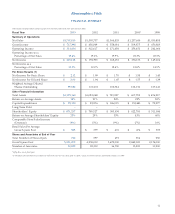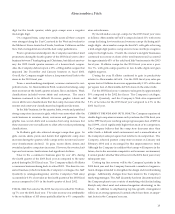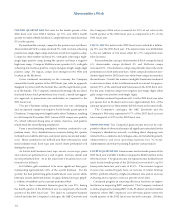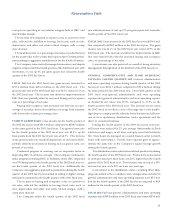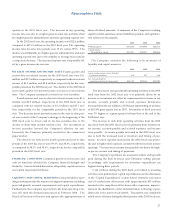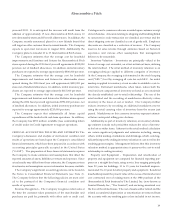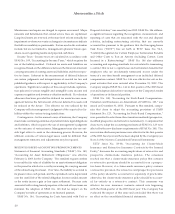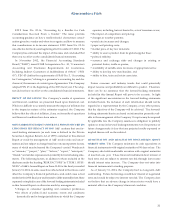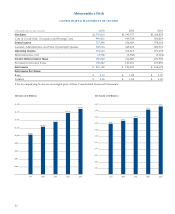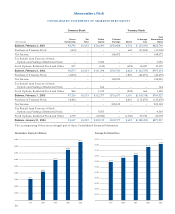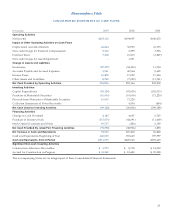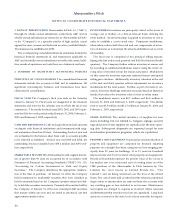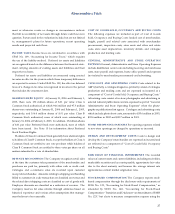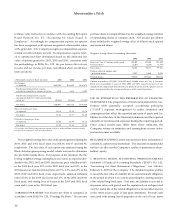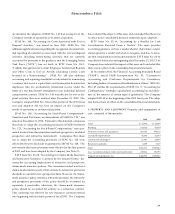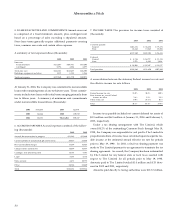Abercrombie & Fitch 2003 Annual Report Download - page 22
Download and view the complete annual report
Please find page 22 of the 2003 Abercrombie & Fitch annual report below. You can navigate through the pages in the report by either clicking on the pages listed below, or by using the keyword search tool below to find specific information within the annual report.
Abercrombie &Fitch
Maintenance and repairs are charged to expense as incurred. Major
renewals and betterments that extend service lives are capitalized.
Long-lived assets are reviewed at the store level at least annually for
impairment or whenever events or changes in circumstances indicate
that full recoverability is questionable. Factors used in the evaluation
include, but are not limited to, management’s plans for future oper-
ations, recent operating results and projected cash flows.
Income Taxes - Income taxes are calculated in accordance with
SFAS No. 109, “Accounting for Income Taxes,” which requires the
use of the liability method. Deferred tax assets and liabilities are
recognized based on the difference between the financial statement
carrying amounts of existing assets and liabilities and their respec-
tive tax bases. Inherent in the measurement of deferred balances
are certain judgments and interpretations of enacted tax law and
published guidance with respect to applicability to the Company’s
operations. Significant examples of this concept include capitaliza-
tion policies for various tangible and intangible costs, income and
expense recognition and inventory valuation methods. No valuation
allowance has been provided for deferred tax assets because man-
agement believes the full amount of the net deferred tax assets will
be realized in the future. The effective tax rate utilized by the
Company reflects management’s judgment of the expected tax lia-
bilities within the various taxing jurisdictions.
Contingencies - In the normal course of business, the Company
must make continuing estimates of potential future legal obligations
and liabilities, which requires the use of management’s judgment
on the outcome of various issues. Management may also use out-
side legal advice to assist in the estimating process. However, the
ultimate outcome of various legal issues could be different than
management estimates, and adjustments may be required.
RECENT LY ISSUED ACCOUNTING PRONOUNCEMENT S
Statement of Financial Accounting Standards (“SFAS”) No. 143,
“Accounting for Asset Retirement Obligations,” was effective
February 2, 2003 for the Company. The standard requires entities
to record the fair value of a liability for an asset retirement obligation
in the period in which it is a cost by increasing the carrying amount
of the related long-lived asset. Over time, the liability is accreted to
its present value each period, and the capitalized cost is depreciated
over the useful life of the related obligation for its recorded amount
or the entity incurs a gain or loss upon settlement. Because costs
associated with exiting leased properties at the end of lease terms are
minimal, the adoption of SFAS No. 143 had no impact on the
Company’s results of operations or its financial position.
SFAS No. 146, “Accounting for Costs Associated with Exit or
Disposal Activities,” was issued in June 2002. SFAS No. 146 address-
es significant issues regarding the recognition, measurement, and
reporting of costs that are associated with the exit and disposal
activities, including restructuring activities, that are currently
accounted for pursuant to the guidance that the Emerging Issues
Task Force (“EITF”) has set forth in EITF Issue No. 94-3,
“Liability Recognition for Certain Employee Termination Benefits
and Other Costs to Exit an Activity (including Certain Costs
Incurred in a Restructuring.)” SFAS No. 146 also addresses
accounting and reporting standards for costs related to terminating
a contract that is not a capital lease and termination benefits that
employees who are involuntarily terminated receive under the
terms of a one-time benefit arrangement or an individual deferred
compensation contract. SFAS No. 146 was effective for exit or dis-
posal activities that were initiated after December 31, 2002. The
Company adopted SFAS No. 146 in first quarter of the 2003 fiscal
year and adoption did not have an impact on the Company’s results
of operations or its financial position.
SFAS No. 148, “Accounting for Stock-Based Compensation–
Transition and Disclosure–an Amendment of FASB No. 123,” was
issued on December 31, 2002. Pursuant to this standard, compa-
nies that chose to adopt the accounting provisions of FASB
Statement No. 123, “Accounting for Stock-Based Compensation,”
were permitted to select from three transition methods (prospective,
modified prospective and retroactive restatement). Companies that
chose not to adopt the accounting provisions of SFAS No. 123 were
affected by the new disclosure requirements of SFAS No. 148. The
new interim disclosure provisions were effective for the first quarter
of the 2003 fiscal year and have been adopted by the Company (see
Note 2 of the Notes to Consolidated Financial Statements).
EITF Issue No. 03-08, “Accounting for Claims-Made
Insurance and Retroactive Insurance Contracts by the Insured
Entity,” discusses the accounting implications of retroactive and
prospective claims-made insurance policies. The consensus
reached was that a claims-made insurance policy that contains
no retroactive provisions should be accounted for on a prospec-
tive basis. However, if a claims-made insurance policy contains
a retroactive provision, the retroactive and prospective provisions
of the policy should be accounted for separately, if practicable;
otherwise, the claims-made insurance policy should be account-
ed for entirely as a retroactive contract. This consensus was
effective for new insurance contracts entered into beginning
with the third quarter of the 2003 fiscal year. The Company has
evaluated the impact of this issue and concluded that there was
no effect on the consolidated financial statements.
20



